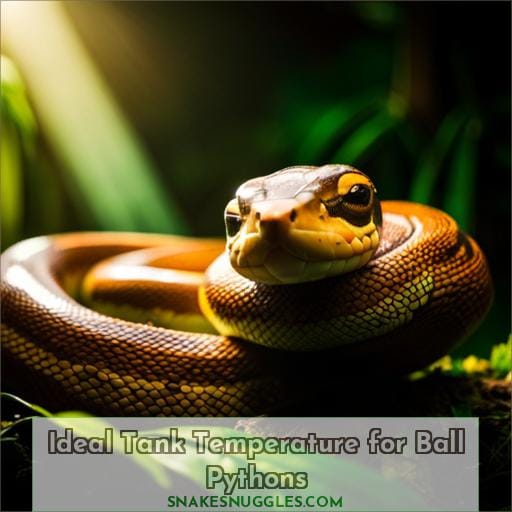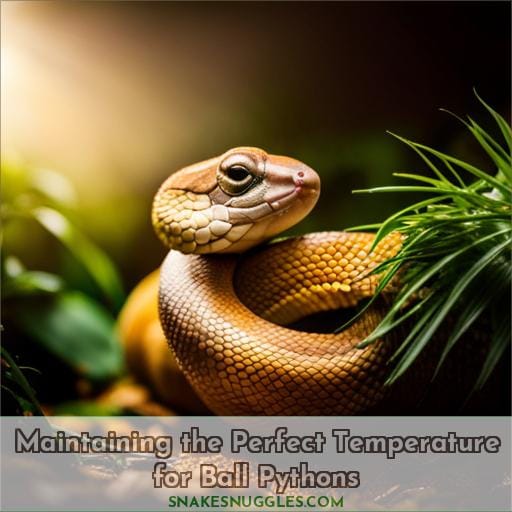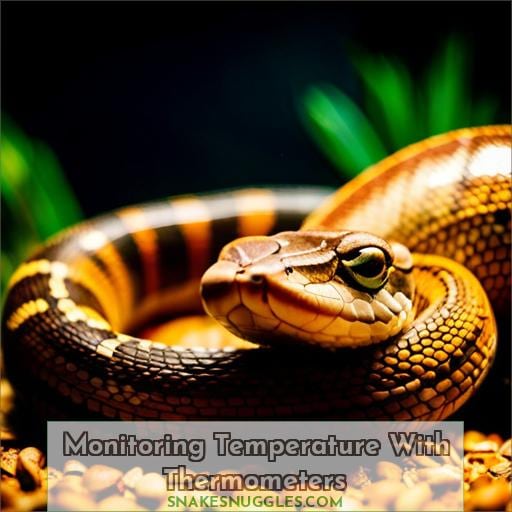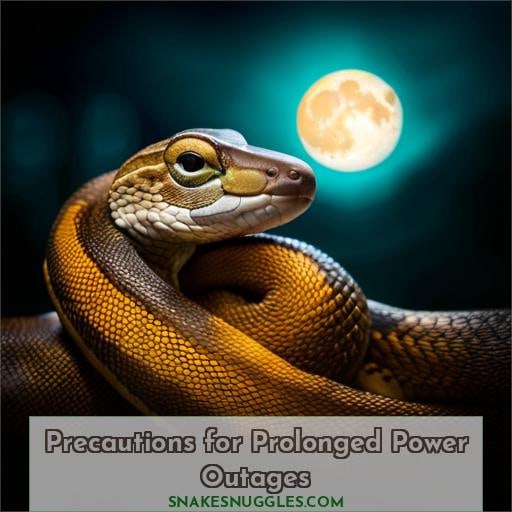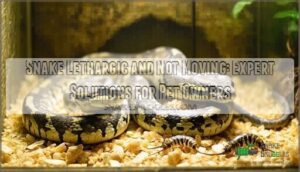This site is supported by our readers. We may earn a commission, at no cost to you, if you purchase through links.
 When it comes to pet reptiles, power outages can be a real nightmare. Take the case of Dom and Cait for example – they had six pets in total, including their beloved ball python ‘Booper’! When there was an unexpected power outage in their area one day, Dom and Cait were left wondering: How long could Booper go without heat?
When it comes to pet reptiles, power outages can be a real nightmare. Take the case of Dom and Cait for example – they had six pets in total, including their beloved ball python ‘Booper’! When there was an unexpected power outage in their area one day, Dom and Cait were left wondering: How long could Booper go without heat?
The answer is not very long – Snakes can only last for a few hours without any type of heat source before their body starts to shut down. As responsible pet owners, they knew that this meant providing Booper with an artificial heater that remains on constantly in order to maintain the perfect temperature range required by ball pythons.
In this article, we will discuss how exactly you should go about doing just that as well as what happens if your snake gets too cold and other strategies you can use to minimize heat loss from your enclosure.
Table Of Contents
- Key Takeaways
- Importance of Heat for Ball Pythons
- Ideal Tank Temperature for Ball Pythons
- The Consequences of Cold Exposure for Ball Pythons
- Maintaining the Perfect Temperature for Ball Pythons
- How Long Can a Ball Python Go Without Heat?
- Strategies to Minimize Heat Loss in Ball Python Enclosures
- Monitoring Temperature With Thermometers
- Understanding the Temperature Range for Ball Pythons
- Precautions for Prolonged Power Outages
- Conclusion
Key Takeaways
- Ball pythons require continuous heat for survival, especially in artificial environments.
- Maintaining specific temperature ranges is crucial for their metabolism, digestion, and overall health.
- During power outages, having backup power solutions like generators is essential to prevent cold exposure and related health problems.
- Regular temperature monitoring and insulation techniques help ensure the well-being of pet ball pythons.
Importance of Heat for Ball Pythons
You must provide an appropriate heat source for your ball python, as it’s essential to ensure their bodily functions are functioning properly, and a proper heat source setup can be achieved by creating a thermal gradient with the right heat lamp wattage, as it’s essential to ensure their bodily functions are functioning properly. Heat helps them regulate their metabolism and digestion, while also enabling movement within the enclosure.
Without the right temperature levels in place, behavioral responses can be affected due to thermal regulation problems and changes in metabolic rate. In addition to providing basking spots that mimic natural sunlight absorption where temperatures should not exceed 95°F, tank heaters should also be used to maintain a cooler area of 75°F with an overall tank temperature of 80°F.
Ball pythons can endure up to 6 hours at this level before adverse effects start appearing. However, if temperatures drop below 65°F even for just a few hours, they may become fatal. Therefore, emergency measures such as using generators or hot water-filled containers have been recommended by snake enthusiasts when power outages occur unexpectedly.
It’s clear that pet owners need to take extra caution when caring for these reptiles since prolonged exposure without adequate warmth could lead to hypothermia, resulting in further health issues like respiratory infections, which could compromise their well-being.
Ideal Tank Temperature for Ball Pythons
Maintaining the right tank temperatures is a critical part of caring for your ball python. Optimal heating techniques, such as using heat mats and basking spots, are necessary to ensure that the snake’s environment stays within its desired temperature range.
Establishing a proper heat gradient in the enclosure helps with thermoregulation and provides enough warmth for digestion. Heat source reliability is also important; you should always have backup power solutions ready if needed in case of an emergency or power outage.
Additionally, seasonal temperature adjustments may be required depending on where you live—but make sure not to exceed 95°F! It’s essential that pet owners take their ball pythons’ needs into consideration when setting up their enclosures, such as a proper thermal gradient setup, as too high or low temperatures can cause hypothermia, which can lead to illnesses and other health issues
.
With careful planning regarding heating methods as well as regular monitoring of your snake’s habitat, you’ll be able to create an optimal living space for them!
The Consequences of Cold Exposure for Ball Pythons
When it comes to ball pythons, cold exposure can be deadly. The warm-blooded reptiles are most comfortable at temperatures ranging from 75°F to 90°F and should never be exposed to anything colder for too long.
Prolonged cold exposure leads to hypothermia and other serious health risks in these animals, including respiratory infections and a weakened immune system. It’s important for pet owners of ball pythons—or any other reptile species—to understand the dangers posed by inadequate heat sources.
Even several hours at below 65°F can prove fatal if not addressed quickly enough. In emergencies, hot water bottles or ceramic lamps may offer some relief while also providing much-needed warmth with minimal risk of fire or burns when used correctly (always use thermostats!).
If power is out due to a natural disaster or equipment malfunction, generators can help maintain heating elements until everything’s back up again.
The thermal gradient created inside the enclosure gives snakes both cooler spots they need but also warmer areas where they bask in order to stay healthy and active all year round – so make sure there are plenty available along with proper monitoring throughout its lifespan!
Establishing quick solutions such as emergency measures discussed above will ensure your precious pet continues living happily without fear from sudden changes in temperature due to illness risks associated with chilly climates!
Maintaining the Perfect Temperature for Ball Pythons
It is essential to maintain the perfect temperature for ball pythons as cold exposure can have severe consequences. Understanding the effects of cold on ball pythons and having emergency measures in place to keep them warm is both vital for their health and longevity.
Effects of Cold on Ball Pythons
Without warmth, ball pythons can quickly run into danger like a fish out of water. Cold temperatures put them at risk for energy depletion, health issues, and respiratory susceptibility that could threaten their survival.
Exposure to cold decreases the temperature inside the snake’s body below 65°F, which is fatal if sustained for too long. Prolonged exposure leads to hypothermia and an inability to move or digest food properly, increasing vulnerability to illnesses such as pneumonia or parasitic infections.
Pet owners must provide alternative heat sources in emergency situations with hot containers of water or by holding onto their snake until they get help from a generator during power outages. All while making sure ambient room temperatures are regulated above 75°F with adjustable tank heaters and basking spots up around 90°F but not exceeding 95°F.
The consequences of inadequate heating cannot be ignored when caring for reptiles like ball pythons; immediate action can mean a life-saving difference!
Emergency Measures for Maintaining Heat
In emergencies, you must take quick action to provide alternative heat sources for your ball python’s enclosure. Consider using items like heat lamps or heating element failures, or insulation techniques to create a temperature gradient that will keep them warm and safe.
Thermal blankets can also be used in case of an emergency power outage. Proper care should always be taken when managing the temperatures within their tank. In the event of a prolonged power outage, it is important to have backup plans in place, such as generators or hot water-filled containers, so that your cold-blooded animal can stay at optimal health during this time.
Taking these precautions ahead of time provides peace of mind, knowing you’re prepared for any situation and ensuring both yours and your pet’s safety!
How Long Can a Ball Python Go Without Heat?
You know how important it is to provide heat for your ball python, but do you know how long they can go without it? Well, the answer might surprise you. Ball pythons are cold-blooded reptiles and need external warmth sources in order to survive and thrive.
Here are three key points on their temperature requirements:
- They should have an overall tank temperature of 80°F with a cooler area of 75°F along with a basking spot around 90°F – anything above 95°F puts them at risk of overheating.
- Without this warmth, they can only last 6 hours at 75°F before their health begins to deteriorate; prolonged exposure below 65°F could be fatal!
- Unexpected power outages or other factors causing heat loss must be addressed immediately by snake owners as hypothermia from extended periods without proper temperatures leads to respiratory infections and other serious health risks for your pet reptile pal!
To avoid these issues, make sure that alternative heating options like hot water bottles or even holding them close against your body until power is restored may help save the day during emergencies — as well as using thermometers regularly so that you’re aware if there’s any drop in temperatures due to sudden changes or events like shedding where extra care needs to be taken into account too!
So when it comes down to brass tacks, don’t take chances when caring for ball pythons — always keep up with providing adequate warming solutions regardless of whether through traditional methods such as lamps/heat mats/generators, or creative alternatives like those mentioned earlier.
Strategies to Minimize Heat Loss in Ball Python Enclosures
To protect ball pythons from the serious health risks associated with inadequate heat, it’s important to create an enclosure that minimizes thermal losses. A variety of insulation techniques can be employed to ensure optimal tank temperatures are maintained throughout brumation and periods of inactivity.
Heat-efficient lighting should also be installed, such as ceramic bulbs or radiant heat panels, which provide focused warmth without overheating.
Thermal barriers like blankets can help keep enclosures warm by trapping the air inside for longer durations. Certain substrate choices may also help retain heat more effectively than others.
The humidity level must also remain within ideal limits. If it’s too low, then body temperatures will decrease faster due to evaporation cooling effects on reptilian skin surfaces.
Additionally, a basking spot created by a consistent wattage bulb or lamp should allow snakes to access their preferred temperature range during active hours. They can bask under its rays for prolonged periods of time before retreating back into cooler areas away from direct light exposure later on in the day cycle rotation process.
Overall, proper care and consideration taken towards maintaining correct environmental conditions is key when it comes to keeping healthy pet snake enclosures at appropriate levels year-round. This is important no matter what indoor room décor changes occur over time, either purposely or accidentally through natural causes such as seasonal weather shifts outside, etcetera.
So just make sure all factors have been thoughtfully discussed beforehand whenever possible before any large-scale alterations take place inside living spaces, especially related directly involving heating elements used up close near sensitive reptiles like these ones here mentioned today specifically regarding Ball Pythons and their unique needs compared relative other species found elsewhere both domestically and abroad.
Monitoring Temperature With Thermometers
Monitoring temperatures with thermometers is crucial for ensuring your ball python’s enclosure stays within the ideal range. Accurate thermometer placement is a key component of successful temperature management.
It allows you to assess heat gradients and make necessary seasonal adjustments. Good thermometer placement strategies can help ensure that all areas in the tank remain at optimal levels.
When selecting a thermometer for your snake’s enclosure, make sure it is accurate. Readings need to stay consistent over time. Even small inaccuracies could lead to serious consequences down the line. Additionally, place thermometers away from direct light sources or other external heating elements.
This will give you more reliable readings throughout different parts of the environment.
Remote temperature monitoring systems can also be used to keep a closer eye on conditions inside the tank from outside it. Take into account any potential changes that might occur during certain seasons or times of year, such as humidity levels or ambient air temperatures, before making any major adjustments.
These factors can have an effect on overall reptile heat source requirements within their enclosures.
Understanding the Temperature Range for Ball Pythons
It’s essential to understand the temperature range that ball pythons need for optimal health, so their environment can be kept safe and warm.
A thermal gradient should be maintained in the enclosure: one cooler area of 75°F (23.9°C), an overall tank temperature of 80°F (26.7°C), and a basking spot around 90-95 °F (32-35 °C).
Seasonal variations may also impact behavioral responses such as hibernation patterns, so it is important to monitor temperatures closely according to where you live.
The metabolic rate will suffer if conditions deviate from this range. Tropical snakes used to higher temperatures can quickly become lethargic in lower level heat like a hotel room!
Insulating enclosures with appropriate bedding material helps retain warmth while avoiding overheating, which could lead to more serious health problems or even death if left unchecked for too long.
Cold-blooded creatures rely on external sources like tank heaters or basking spots, which imitate natural sunlight absorption and provide necessary warmth.
That being said, it’s never advisable that ball pythons are exposed without any heating elements whatsoever because their bodies start deteriorating after 6 hours at 75˚F (23˚C), and below 65˚F (18˚C) for a few hours can prove fatal!
Precautions for Prolonged Power Outages
When it comes to protecting pet ball pythons from an unexpected power outage, there are several precautions that can be taken. From using body heat as a temporary source of warmth to investing in generators for longer-term solutions, these measures will ensure your snake’s enclosure stays at the optimal temperature during any emergency situation.
Using Body Heat to Provide Temporary Warmth
In an emergency, you can use your own body heat to provide temporary warmth for a ball python’s enclosure. This natural heat source is beneficial in power outages when other solutions may not be available.
As long as the snake isn’t kept too close or exposed to extreme temperatures, it can help keep them safe during short-term situations.
To do this successfully, one must practice proper safety techniques and monitor the snake’s reaction closely. By learning about backup generators and basking spots for pet reptiles ahead of time, people are better equipped with reliable emergency heat solutions if needed.
Using body heat safely also allows owners to bond more deeply with their snakes through gentle contact while providing comfort at difficult times such as power outages or illness recovery periods. Heat gradient techniques involve slowly exposing our warm bodies until they reach a comfortable temperature range for our scaly friends before letting go again slowly and cautiously once satisfied that no harm has been done by overexposure or sudden changes in temperature levels from human contact versus ambient air temperatures inside the vivariums themselves which should remain above 75°F at all times even during emergencies like prolonged blackouts involving lack of electricity due to storms etcetera.
Ultimately using body heat responsibly is just another way we show how much we care about these amazing reptilian creatures sharing our homes!
Backup Power Supply for Ball Python Enclosures
You may want to consider investing in a reliable backup power supply for your ball python enclosure, so you can keep your pet comfortable and safe during prolonged power outages. A generator or battery backup system is an ideal way to maintain heat stability within the vivarium without interruption.
Reptile owners should also have other heating solutions at hand, such as hot water bowls that can be placed in the tank if needed.
Additionally, it’s important to assess any changes after a lengthy outage by having a vet visit and closely monitoring the feeding behavior of your snake. This will help identify any potential health issues early on before they become more serious down the line.
Preparing ahead of time with multiple safety measures ensures both comfort and safety for snakes living indoors under our care!
Conclusion
It’s essential to provide the ideal temperature for ball pythons, as they cannot survive more than six hours without heat. Cold exposure can lead to hypothermia and other severe health issues, so ensuring temperatures stay within the suggested range of 75°F to 90°F is paramount.
To minimize heat loss, use a tank heater, basking spots, and thermometers to track temperatures. In the event of a power outage, use a generator and hot water-filled containers to keep your pet warm.
Time is of the essence when it comes to saving your ball python from the dangers of cold exposure, so maintain the perfect heat for your beloved pet.


